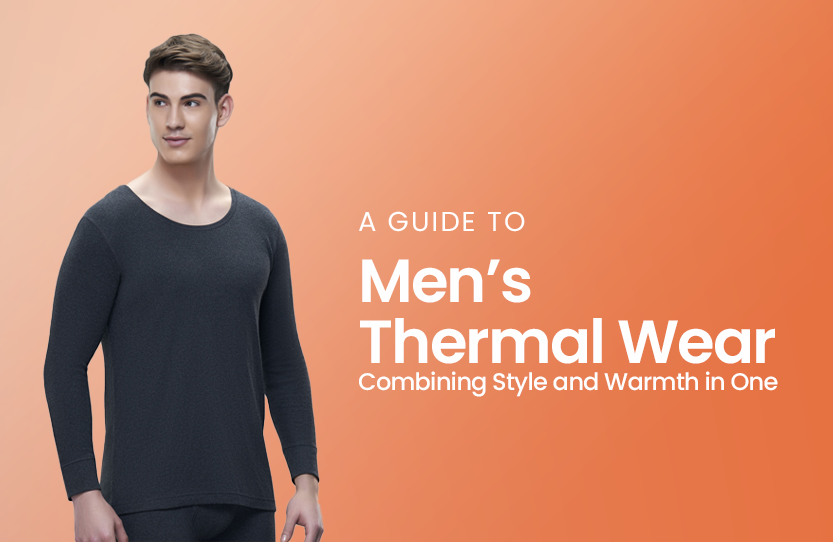Style
A Guide to Men’s Thermal Wear: Combining Style and Warmth in One
It is that time of the year, when we all go on the internet and frantically tap our keyboards to search, “winter thermal wear”, “thermal wear men”, and “thermals”. There are many thermal wear options out there, it can become confusing to choose the right one. But don’t fret, FASO is here to help you choose the best, which will always stay in your wardrobe’s crest. With thermals’ versatile nature, they not only provide us warmth but also enable us to experiment with different types of clothing we wish to wear on the outside layer, without jeopardising the style quotient.
When it comes to winter thermal wear, there are a plethora of options ranging from ultra-lightweight to wool thermals. Keep the cold away in style and explore with us the different types of thermals that exist. In this guide, you will find how men’s thermal wear comes in various materials such as silk and cotton and that it can also be the perfect base layer for a winter sport or activity. Thermal wear is a versatile and timeless piece of clothing that is a must-have for any winter wardrobe.
Men’s Thermal Wear
Let’s go on a little journey to the past and see how men’s thermal wear came to be. Thermal wear has been around for centuries, with its original purpose being to provide warmth and protection against the cold elements of nature. Today’s thermal wear is said to have emerged from two popular clothing known as the “long johns” and “union suits”. Although the original inventor of the long john is unknown, there were two companies that were producing this type of clothing during the 18th and 19th centuries.
One of the companies was John Smedley’s company, founded in 1784 at Lea Mills, Matlock, Derbyshire where he manufactured his line of clothing. Another veteran was Stanfield’s, a Canadian company founded by Charles E. Stanfield. Stanfield started his factory in 1856 at Tryon Woolen Mills in Tryon, Prince Edward Island. It is said that long johns evolved from sleepwear. They were a two-piece item, with a top and a bottom, whereas, union suits were one-piece clothing which had a rear flap to conveniently attend to nature’s calls.
At that time, long johns were usually made out of cotton, and the fabric had a waffle pattern on it, which helped in improving the look and feel of the apparel. The waffle stitch used in the fabric of this item aided in insulating the body while keeping it lighter and more breathable than wool.
Today’s men’s thermal wear is better at trapping body heat than the jeans and shirts that we wear. Thermal clothing not only maintains the existing body heat effectively but also keeps the sweat or moisture content away from the body so that you don’t feel chilly. Thermal wear regulates body temperature well because of the layer of air that is kept between the skin and the thermal layer. FASO offers you the best men’s thermal wear garments that are not only comfortable, breathable and moisture-wicking but are also resistant to odour and provide full mobility. And they can be layered under your lovely jeans and shirts.
Types of Thermal Clothing
When searching for the perfect winter thermals for men, two important aspects of the cloth’s fabric should be kept in mind, that is, the weight of the fabric and the material of the fabric. Why? Because men’s thermal wear heavily depends on these two elements.
Types Based on the Weight of the Fabric
- Ultra-Lightweight or Micro Lightweight
- Lightweight
- Midweight
- Heavyweight
Selecting the type of thermal based on weight depends upon the climate you live in. If the climate is mild to moderate, then Ultra-Lightweight and Lightweight thermals are best. If you live in a place where the winter or cold weather goes beyond moderate and is extremely cold, then Midweight to Heavyweight thermals are the ones to wear. Since all of these are comfortable and versatile, you can wear them daily and indulge in various outdoor activities as well.
Types Based on the Material of the Fabric
- Cotton Thermals
Cotton is a natural and breathable material that is often used in clothing. Cotton thermals are comfortable and softer to wear but they take longer to dry and are less effective at wicking moisture away from the skin. However, when combined with other materials, they become more powerful in their performance. - Synthetic Thermals
Thermal wear made from synthetic fibres has materials such as polyester, polypropylene, or nylon. These materials are lightweight, breathable and provide good thermal insulation. They are also quick-drying and effective at wicking moisture away from the skin. Because of their technical properties, synthetic thermal wear is popular among athletes and outdoor enthusiasts. They are also affordable and less expensive than wool or silk thermals. - Wool Thermals
Wool is a natural, renewable and biodegradable fibre that is known for its warmth, moisture-wicking, and odour-resistance properties. Wool thermal wear is made from different types of wool such as Merino wool which is soft and comfortable to wear. - Silk Thermals
Silk is a natural, lightweight, and breathable material that is known for its softness, smoothness, and draping ability. Silk thermal wear is typically made from a blend of silk and other fibres such as wool or polyester which help to increase its insulating properties. Silk thermal wear is also moisture-wicking and hypoallergenic, making it a good option for people with sensitive skin.
Benefits of Thermal Wear in Winter Season
Men’s thermal wear comes in numerous styles and fabrics. And there are just as many benefits that it provides.
- Insulation:
Winter thermal wear is designed to provide insulation and trap heat close to the body so that it can keep the wearer warm in cold weather conditions. - Layering:
The thermal wear for men is also designed to be worn as a base layer under other layers of clothing, allowing for more effective layering and providing added warmth and protection from the cold. - Moisture-wicking:
Many thermal wear materials are designed to wick moisture away from the skin, keeping the wearer dry and comfortable during winter. - Lightweight and easy to pack:
Winter thermal wear is typically lightweight and easy to pack, making it a great option for travel or outdoor activities. - Variety of materials:
Thermal wear comes in a variety of materials such as wool, silk, polyester, cotton, etc. Each material has its own specific properties and benefits, allowing the person to choose what is best for them. - Comfort:
Thermal wear is designed to be comfortable to wear that fits snugly around the body which makes it a great option for everyday wear in cold weather. - Versatility:
Thermal wear can be used as daily wear and can be worn for a variety of activities too, such as hiking, skiing, and camping. You can even accessorize your winter look by pairing your thermal wear with a scarf and a hat.
FASO offers thermal wear for men that are soft, comfortable, breathable, and flexible. Our thermal clothing is made from environment and skin-friendly organic cotton blended with polyester fabrics. We take extra care by including blind reinforced seams waistband and R/N full sleeve with rib and ribbed elastane cuffs in the thermals for men to eliminate the issue of riding up. Go ahead and start your winter season by layering your clothes in style with the best of FASO’s thermals.


